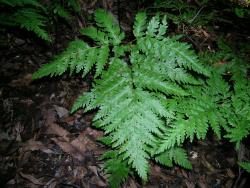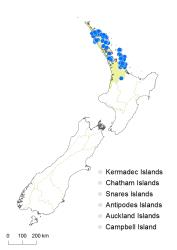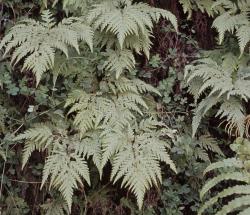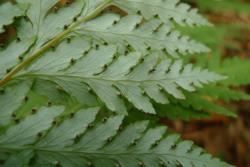Rhizomes long-creeping, 2–6 mm diameter, bearing dark, stiff, multicellular hairs 2.5–5 mm long. Fronds 370–1270 mm long. Stipes 150–700 mm long, chestnut-brown, glabrous or hairy at very base, polished. Laminae pinnate-pinnatifid at apex to 3-pinnate-pinnatifid or rarely 4-pinnate at base, ovate or broadly ovate, 180–570 mm long, 160–425 mm wide, yellow-green on adaxial surfaces, usually glaucous on abaxial surfaces or sometimes green, herbaceous to coriaceous, glabrous. Primary pinnae in 7–15 pairs, widely spaced, elliptic or narrowly ovate at lamina apex to ovate or broadly ovate at base of rachis; the longest at the base, 130–420 mm long, 80–230 mm wide, long-stalked. Secondary pinnae elliptic or narrowly ovate at apex to ovate at base of primary pinna, the longest 65–160 mm long, 25–90 mm wide, stalked to decurrent; the basal basiscopic longer than the acroscopic on the lowermost primary pinnae. Longest tertiary pinnae 27–60 mm long, 8–30 mm wide, decurrent. Sori terminating veins at margins of lamina, borne at notches of ultimate segments; indusia urceolate; paraphyses present as multicellular trichomes; sporangia borne on a short receptacle 1–3 mm long, projecting beyond the indusia at maturity.
This species is easily recognised by its creeping rhizomes, ovate fronds with white or glaucous undersides, marginal sori and urceolate indusia with exserted receptacles.
North Island: Northland, Auckland.
Altitudinal range: 0–550 m.
Loxsoma cunninghamii occurs in lowland areas of Northland, Auckland and the Coromandel Peninsula, extending from near Kaitaia to Whangamatā, with an outlying population on Maungatautari Mountain in the Waikato region. It occurs from near sea level extending up to 500 m in the Mataraua Forest and 550 m on Great Barrier Island.
Occurs under tall mānuka and kānuka scrub, on scrub margins, in clearings, or in open tawa, podocarp, kauri and broadleaved forest, usually on banks, tracksides, roadsides or streamsides where it often spreads vegetatively. It has also been recorded occasionally under Pinus plantations.
n = 50 (Brownsey 1975).
The species is less common than formerly, having been much reduced in distribution in Northland by land development. It is still abundant in Coromandel.







